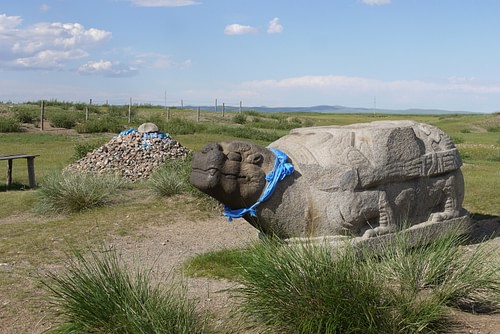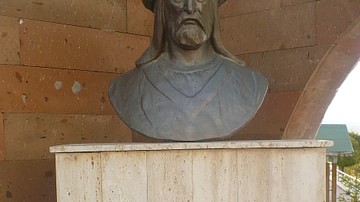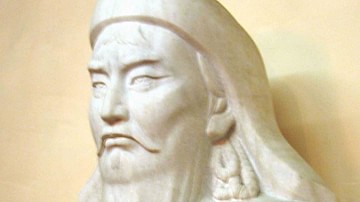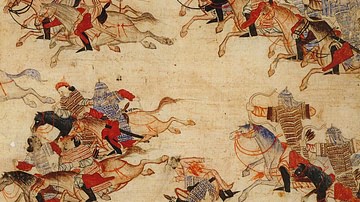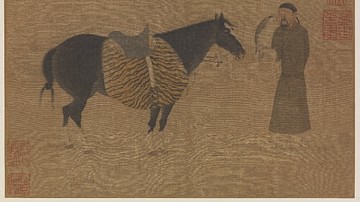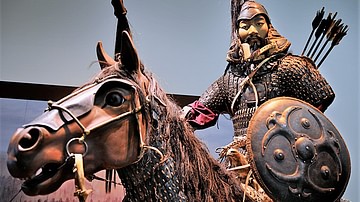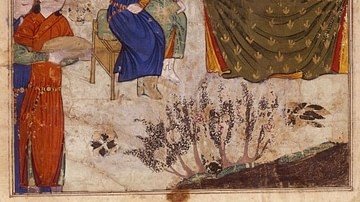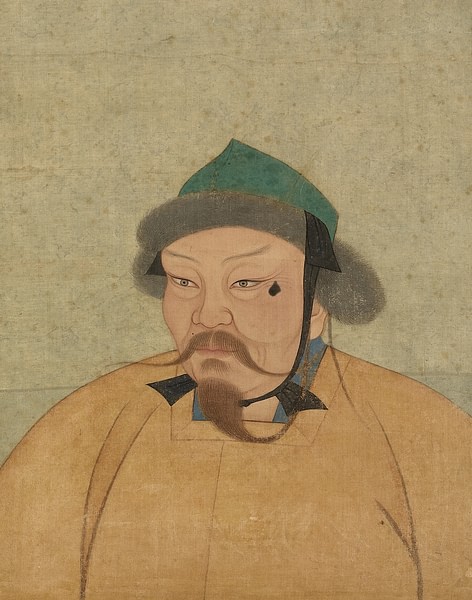
Ogedei Khan (aka Ogodei) ruled the Mongol Empire from 1229 to 1241. He was the third son of Genghis Khan (r. 1206-1227), the empire's founder. Ogedei's accomplishments included creating a new capital at Karakorum, establishing a system of regional governance and taxation, and defeating the long-time enemy of the Mongols, the Jin state of northern China.
Ogedei Khan enjoyed many other military victories in Western Asia from Afghanistan to Georgia, and the great cities of the Bulgars and Rus were sacked as his armies swept ever further west and attacked Poland and Hungary. Just as the Mongols seemed about to sweep through Europe, the invaders returned home following news of the Great Khan's death of either a stroke or organ failure in December 1241, most likely brought on by one of the heavy drinking bouts for which he was infamous.
Early Life & Succession
Ogedei was born, c. 1186, the third son of Genghis Khan, the founder of the Mongol Empire. He had three brothers: Jochi, Chagatai (Chaghadai) and Tolui (Tului). Like them, Ogedei assisted his father on several military campaigns, notably against the Khwarazm Empire from 1219 to 1225. Before he died of natural causes in 1227, Genghis Khan had instructed that his empire be divided into four khanates with each of his sons ruling one of them (although Jochi would predecease his father in 1227). Ogedei was selected to rule above his siblings as the Great Khan or 'universal ruler', a position he was formally awarded in 1228 at the kurultai conference of Mongol tribal chiefs (which Ogedei at first refused but then accepted in 1229). Genghis, meanwhile, was buried in secret in the vicinity of the sacred mountain Burkan Kuldun, and Ogedei sacrificed 40 slave girls and 40 horses to accompany his father into the next life.
Ogedei was a surprising choice for khan because he already had a reputation for often being drunk. He was chastised for his drinking by his brother Chagatai but, not being unaware of the problem, Ogedei did offer to have a supervisor check how much alcohol he drank and to limit the number of cups per day to a specified number. Ogedei then made sure he was always served his favourite tipple in very large cups. Neither had Ogedei shown any great particular promise as a military commander. He was, however, likeable and willing to take the advice of his more senior ministers and commanders, essential qualities in the complex web of Mongol clan politics. Most importantly of all, he was his father's choice and Genghis Khan was now already seen as a deified spirit whose word was law. Thus, Tolui, who had been acting as regent, handed over the reins of government to Ogedei and a new era of Mongol rule began.
Government Apparatus
Ogedei Khan had an immediate problem in the first years of his reign in that his state treasury was empty and his followers and armies needed booty to reward them for their loyalty and keep them together. One solution was for Ogedei to impose taxes on the peoples his father had conquered. This idea is traditionally credited to Yelu Chucai (1190-1244), a khitan who was one of Ogedei's senior ministers and who is credited with coining the maxim: 'you can conquer an empire on horseback, but you cannot govern it on horseback.' Chucai's role in government may have been exaggerated by ancient Chinese sources and, in any case, taxing rather than outright confiscation was hardly a new policy to better govern a territory.
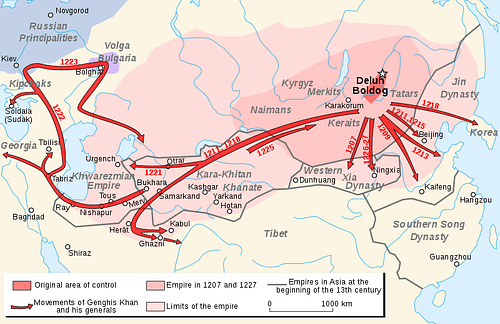
Consequently, members of the imperial bodyguard (Kesikten) and ministers were charged with acting as regional governors (daruqachi) and supervising the local inspectors (often Muslim agents) who had to actually collect the tax. This plan was aided by the creation of local branches of government made up of a mix of officials and imperial clan leaders. The system was a success, even if it later led to abuses. Taxation and governance were made more efficient in 1234-6 when a census was conducted across northern China and by the parallel apparatus of jarquci, officials who checked that clans received the war booty due to them and who eventually became coordinators and administrators in other government business, too. With his bureaucracy in order and income stabilised, Ogedei was ready to embark on expanding his territory. There was one essential ingredient still missing from his empire, though; he still did not have a capital.
Karakorum
The Mongol Empire urgently needed a capital city where revenue could be accumulated and some attempt at a centralised government could be made. In short, the nomadic Mongols needed to make themselves a lot more stationary and put down some permanent roots. Ogedei began this process by ordering the building of a walled capital in 1235. The place was to be Karakorum (aka Qaraqorum and today known as Harhorin) in the Orkhon Valley, 400 km southwest of the present capital of Mongolia, Ulaanbaatar. The city was not large, only 10,000 people at its height resided there, but it was cosmopolitan and would be the first of the Mongol capitals that would later include Daidu (Beijing) and Xanadu. Ogedei himself never lived at Karakorum, preferring instead to roam his empire and stay in the traditional camps of yurt (ger) tents. The khan did visit occasionally and even had a great silver drinking fountain set up in his palace there that served all manner of alcoholic beverages from spouts shaped into snakes and lions.
Karakorum, despite needing to have hundreds of cartloads of food shipped in to feed its population, became an important logistics centre and repository of the empire's resources. In addition, many merchants travelled there, encouraged by its location on the Silk Roads and the khan's generous prices for their goods. Consequently, the city soon boasted large and regular markets. In time, fine stone buildings were erected by followers of Taoism, Buddhism, Islam, and Christianity.
Karakorum was not only connected to other parts of the empire by roads which were patrolled to make them safe from robbers but Ogedei also greatly extended the messenger system (the Yam) that spread across Mongolia and even developed a system of passports so that messengers could receive various entitlements at the many rest stations. The khan was responsible, too, for the innovation of protecting hundreds of wells with high walls so that regular water supply could aid the movement of armies and merchants across Asia.
Expanding the Empire
The Mongol armies under Genghis Khan had been tremendously successful but occupation had not been attempted in most of the conquered territories. For this reason, Ogedei needed to send troops back to extract tribute in such places as Persia, Afghanistan, and Siberia. The priority, though, remained their old foe the Jin state in northeast China, still ruled by the Jin Jurchen Dynasty. Ogedei and his brother Tolui both participated but the army was led in the field by the gifted general Subutai (aka Sube'etei, 1176-1248), known as one of the 'Four Hounds' of the khan. The Mongols attacked the Jin in 1230-1. Although successful, Tolui died during the war, but just how is not known for certain. The Jin capital of Kaifeng fell after a lengthy siege in 1233, and one final campaign in February 1234 brought about the suicide of the Jin emperor, Aizong (r. 1224-1234) and the total and final collapse of the Jin state.
Meanwhile, and not for the first time, Korea also faced Mongol armies on its lands from 1231. As a consequence, the Korean state of Goryeo was forced to move its capital to Ganghwa Island in 1232. While the ruling elite was safely ensconced on their island, the rest of the Goryeo population had to face six Mongol invasions over the next three decades until peace was finally made in 1258. With northern East Asia subdued, the Mongols were now in a position to raid southern China, then controlled by the Song Dynasty (960-1279). That particular prize would have to wait until the reign of Kublai Khan (r. 1260-1294) to fall into Mongol hands, though, as Ogedei turned his attention elsewhere.
On the western side of the Mongol Empire, campaigns were launched in Afghanistan and northern Iran throughout the 1230s, attacking the Khwarazmians following the return from exile of their troublesome leader Jalal al-Din. In 1235 northern Iraq was invaded. Victory followed victory, and the Mongol armies pushed into Azerbaijan, Georgia, and Armenia in 1238, steadily wearing down the fortified towns of the region, sacking such cities as Tiflis (Tbilisi) and extracting tribute from local princes.
There was then a campaign, led once again by Subutai, which marched through Kazakhstan/Uzbekistan to attack Eastern Europe around the Volga river from 1236 to 1242. The army consisted of some 150,000 men and pushed northwards in five different divisions, eventually reaching as far as eastern Hungary and southern Poland and defeating the Bulgars and Rus along the way. Great cities like Kiev (1240), Krakow (1241), Buda and Pest (1241) were sacked and looted. Mongol scouts were then sent ahead of the army as far as Bohemia and Vienna. For the first time, the western world was presented with the horrifying sight of the seemingly unstoppable war-machine that was the Mongol hordes. Fortunately for Europe, in early 1242, the Mongol armies turned for home; they had heard news of Ogedei Khan's death and a successor now had to be chosen.
Death & Legacy
On 11 December 1241 Ogedei, having laid down the foundations for a governable empire that now spanned the whole of Asia, died at the age of 56, perhaps from a stroke or organ failure, although there were rumours, too, of poisoning. He was succeeded by his son Guyuk in 1246 after a brief stint as regent by Ogedei's wife Toregene. Ogedei's own choice for his successor was first his son Kochu, but when he died prematurely, he then chose Kochu's son Shiremun. This choice was ignored by the Mongol tribal leaders, perhaps because Ogedei's final years had seen him decline further and further into alcoholism and he no longer carried the demigod prestige his own father had enjoyed. As it turned out, Guyuk's reign as the third khan of the Mongol Empire would last a mere two years. Guyuk had never been a popular choice, and many nobles, whose loyalties were divided amongst Genghis Khan's descendants, disputed the decision, hence the delay in his nomination after Ogedei's death. It is likely Guyuk was poisoned by a rival.
After two more khans and two regents, the next big step forward for the empire came during the reign of Kublai Khan, the grandson of Genghis who conquered most of what remained of China from 1275 and so caused the collapse of the Song Dynasty in 1279. Kublai then proclaimed himself emperor of the new Yuan Dynasty in China. Over the next two decades, China would become entirely dominated by the Mongols. The Mongol Empire would then go on to more campaigns, including in the Middle East, Korea, and Japan with varying success but ultimately creating one of the largest empires ever seen.
